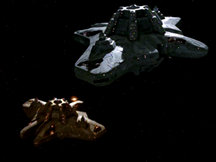 Fallen Federation Fallen Federation
A Closer Look at Voyager's Early Journey
Star Trek: Voyager's first two seasons present a very interesting picture of both the chronology, and the topography of the far Delta Quadrant. Not only is the allocation of time very unusual for a Star Trek series, but the show presents—whether intentionally or inadvertently—the impression that Voyager is unknowingly sailing through a dark mirror of the very home they seek to return to... a Fallen Federation.
Part I: Are We There Yet?
Ordinarily, one envisions a season of Star Trek as being roughly analogous to a single year—but for Voyager's first several seasons, this isn't the case. In fact, the original season 1 might have been meant to cover a good eight months or so; the date of 'six months' is established in the episode "Projections", three episodes before the season 1 finale. (That finale, incidentally, is the 37s, which thematically bookends the season with the journey Janeway mandated for the crew without their input in "Caretaker" being unanimously committed to by the entire crew at the episode's end, chosen of their own free will.)
 However, UPN (the United Paramount Network)'s decision to hold back 4 episodes from the end of season 1 in order to start their fall season of programming a month earlier than anyone else not only consigned the unremarkable episode "Learning Curve" ("Get this cheese to sickbay!") as an impromptu season 1 finale (thematically focusing on the integration of the Starfleet and Maquis crews, it is still serviceable in terms of bookending the season, if a bit lackluster)... it also stuck "Projections" as the third episode of the second season. Which means that the events of the first season end up, inadvertently, totaling up to less than six months... not unusual in the serialized CBS era of Star Trek (where an average Picard season takes place over the space of a few days), but unheard of for 20th century Trek. However, UPN (the United Paramount Network)'s decision to hold back 4 episodes from the end of season 1 in order to start their fall season of programming a month earlier than anyone else not only consigned the unremarkable episode "Learning Curve" ("Get this cheese to sickbay!") as an impromptu season 1 finale (thematically focusing on the integration of the Starfleet and Maquis crews, it is still serviceable in terms of bookending the season, if a bit lackluster)... it also stuck "Projections" as the third episode of the second season. Which means that the events of the first season end up, inadvertently, totaling up to less than six months... not unusual in the serialized CBS era of Star Trek (where an average Picard season takes place over the space of a few days), but unheard of for 20th century Trek.
7 episodes later, in "Cold Fire", we confirm that we are only 10 months out from the events of "Caretaker". In fact, the one-year mark of Voyager's journey in the Delta Quadrant doesn't occur until midway through the second season! We know from later seasons that Voyager does end up in the Delta Quadrant for seven years, but one would hardly know it based on the pace at which the first season and a half was proceeding! (One wonders if this slower pace was originally chosen to ensure that Jennifer Lien's lack of aging a decade-per-year as an Ocampa ought to would be less noticeable...)
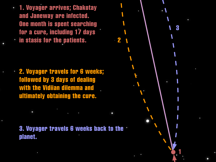 One of the first major catchup points appears in the penultimate episode of season 2, "Resolutions", which between the referenced events before the start of the episode, and the elapsed time within the episode itself, covers almost 4 months; surely a record-length time-span! (Not counting taking-place-in-the-future epilogues or time travel episodes). In total, a week over 5 months elapses between the time that Voyager arrives at 'New Earth' and their eventual return to the farthest point that Voyager had reached during the middle of the episode. Even then, with almost half a year bound up in the course of a single episode, the show's timeline lags behind the season-count; several episodes entering and traveling through the Nekrit expanse make reference to 2 years, halfway through season 3. Even Scorpion references 'less than three years.' "The Year of Hell" (which itself claims the elapsed-time title from "Resolutions", sort of), midway through season 3, hits the three year marker... but by "Night", kicking off season 5, 4 years have passed. The show's timeline finally caught up to the traditional Star Trek season-marker, more than halfway through its run. One of the first major catchup points appears in the penultimate episode of season 2, "Resolutions", which between the referenced events before the start of the episode, and the elapsed time within the episode itself, covers almost 4 months; surely a record-length time-span! (Not counting taking-place-in-the-future epilogues or time travel episodes). In total, a week over 5 months elapses between the time that Voyager arrives at 'New Earth' and their eventual return to the farthest point that Voyager had reached during the middle of the episode. Even then, with almost half a year bound up in the course of a single episode, the show's timeline lags behind the season-count; several episodes entering and traveling through the Nekrit expanse make reference to 2 years, halfway through season 3. Even Scorpion references 'less than three years.' "The Year of Hell" (which itself claims the elapsed-time title from "Resolutions", sort of), midway through season 3, hits the three year marker... but by "Night", kicking off season 5, 4 years have passed. The show's timeline finally caught up to the traditional Star Trek season-marker, more than halfway through its run.
But what does this have to do with the Fallen Federation? Well, believe it or not, travel times are part of the process of forming a map of this strange region.
But before we dive fully into this, let's tackle one of the largest hurdles and logistical issues of Voyager's early days—those most beloved of all Star Trek antagonists, the Kazon.
Part II: A Seska Sidebar
The prospect of a recurring villain for Voyager has always been a complex one—a ship continuing at top speed in a straight line shouldn't really be encountering many recurring foes; they should constantly be leaving everyone behind. Later seasons will deal with this by making the Hirogen nomadic (and thus widespread), and the Malon radiation haulers specifically in the business of traveling to far-flung places away from their own civilization. But in these early seasons, the solution is simply 'their territory is vast.' A functional enough excuse for the Borg, but for the Kazon and the Vidiians? Well, that makes things interesting.
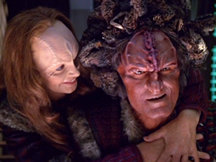 And when it comes to Culluh and Seska, recurring individuals dogging Voyager through that vast territory, many a fan's skepticism has been roused by the notion that the Kazon ships, with their inferior technology, could consistently keep pace with Voyager and serve as recurring nemeses throughout season 2. It's often chalked up alongside the crew, shuttle, and torpedo counts as yet another inconsistency in Voyager's writing. And when it comes to Culluh and Seska, recurring individuals dogging Voyager through that vast territory, many a fan's skepticism has been roused by the notion that the Kazon ships, with their inferior technology, could consistently keep pace with Voyager and serve as recurring nemeses throughout season 2. It's often chalked up alongside the crew, shuttle, and torpedo counts as yet another inconsistency in Voyager's writing.
But let's take a closer look. The power-couple of evil join forces in "State of Flux" (production episode 11), clearly prior to the six month mark in "Projections" (production episode 17). They don't reappear again until "Maneuvers" (P.E. 27), just after the ten month mark—a date Janeway reaffirms in the episode itself. Voyager is decoyed by a buoy (which may well have caused them to double-back); after prior dalliances on the 37s' planet ("The 37s"), Suspiria's array ("Cold Fire"), and a 'significant detour' to the Talaxian system in "Jetrel", it's not inconceivable that the Kazon could have caught up.
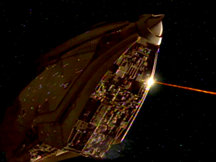 A few episodes later, in "Alliances" (P.E. 31), Voyager stops and waits for the Kazon to come to them, resetting the travel times nicely. Starting with this episode, Michael Jonas serves as a spy for the Kazon, allowing them to track Voyager's every move, and anticipating their ongoing detours in "Dreadnought" (P.E. 34) and "Lifesigns" (P.E. 36). Even so, they are behind Voyager in "Investigations" (P.E. 35), preying on the Talaxian convoy in Voyager's wake, and the ship doubles back to the Kazon to rescue Tom. (Incidentally, this is close to the 1-year mark for Voyager in the Delta Quadrant; Seska and Culluh's entire pursuit up to this point has lasted a little over six months, with Voyager backtracking to them three separate times.) A few episodes later, in "Alliances" (P.E. 31), Voyager stops and waits for the Kazon to come to them, resetting the travel times nicely. Starting with this episode, Michael Jonas serves as a spy for the Kazon, allowing them to track Voyager's every move, and anticipating their ongoing detours in "Dreadnought" (P.E. 34) and "Lifesigns" (P.E. 36). Even so, they are behind Voyager in "Investigations" (P.E. 35), preying on the Talaxian convoy in Voyager's wake, and the ship doubles back to the Kazon to rescue Tom. (Incidentally, this is close to the 1-year mark for Voyager in the Delta Quadrant; Seska and Culluh's entire pursuit up to this point has lasted a little over six months, with Voyager backtracking to them three separate times.)
Finally, the months-long delay in "Resolutions" (P.E. 41) gives Seska and Culluh ample time to catch up to and bypass Voyager, and lay their final traps—seemingly at the very far end of Kazon space, as this serves as Voyager's last encounter with them. Less than a year's pursuit, all told, including nearly 4 months of zero-ground-gained for Voyager for Seska and Culluh to get ahead of them... and only a little over a year's-worth of travel (perhaps less with numerous stops) to get past Kazon space.
All things considered, the timeline works quite believably for Seska and Culluh to continue dogging their heels, and even appear in their path at the end, as they travel nearly the entire breadth of Kazon space in their pursuit. Which is still expansive... but perhaps not as unbelievably so as it first appears.
So, with an investigation of travel-times and Kazon appearances behind us, what can we deduce about the wilds of the Delta Quadrant in Voyager's first two seasons?
Part III: The Fallen Federation
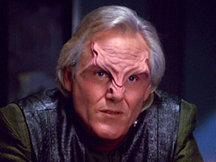 Kazon space is vast—perhaps larger than the original Trabe space that they occupied; it makes sense for the warring sects to spread out, and their territorial claims were clearly often without fully securing the territories involved. Mere claims only. Stretching from at least Ocampa, past Talaxian space and into the regions seen in Basics (though it is entirely possible that they had passed the borders of normal Kazon space already in pursuit of Voyager), the Kazon's greed led them to range far and wide (and perhaps in response, to avoid them, the Talaxians seem to have taken up the same tendency!) However, the compressed timescale of the first two seasons also renders their space (like the Vidiians) deceptively large; Voyager is not traveling through Kazon space for two straight years, but only a little over one year, with several long stops and double-backs in among it; perhaps 1,000 light-years or so, based on Janeway's travel-time estimate in "Caretaker". About an eighth of Federation space, or less. Not so unbelievable. Kazon space is vast—perhaps larger than the original Trabe space that they occupied; it makes sense for the warring sects to spread out, and their territorial claims were clearly often without fully securing the territories involved. Mere claims only. Stretching from at least Ocampa, past Talaxian space and into the regions seen in Basics (though it is entirely possible that they had passed the borders of normal Kazon space already in pursuit of Voyager), the Kazon's greed led them to range far and wide (and perhaps in response, to avoid them, the Talaxians seem to have taken up the same tendency!) However, the compressed timescale of the first two seasons also renders their space (like the Vidiians) deceptively large; Voyager is not traveling through Kazon space for two straight years, but only a little over one year, with several long stops and double-backs in among it; perhaps 1,000 light-years or so, based on Janeway's travel-time estimate in "Caretaker". About an eighth of Federation space, or less. Not so unbelievable.
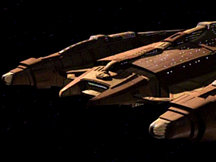 The territory of the Vidiian Sodality is more uncertain. It has a similar terminus (with their last 'real' appearance coming in "Resolutions"), but an unclearer starting location; both Vidiian encounters in the first season involved isolated individuals—a duo ranging for organs, and another with a secret laboratory; it's unclear if either were within Vidiian space proper. Their territory, then, is likely to be smaller than Kazon territory, though still fairly widespread—and again, aided by the compressed timescale of the early seasons in making a wider number of appearances without being that unbelievably vast... especially if Vidiian Honattas range far and wide beyond their territory to procure new organs (a logical deduction, as Vidiian space itself has doubtless been mined out of compatible donors in the space of 2000 years), rendering Voyager's season 1 encounters with them outliers that don't represent actual Vidiian space. The territory of the Vidiian Sodality is more uncertain. It has a similar terminus (with their last 'real' appearance coming in "Resolutions"), but an unclearer starting location; both Vidiian encounters in the first season involved isolated individuals—a duo ranging for organs, and another with a secret laboratory; it's unclear if either were within Vidiian space proper. Their territory, then, is likely to be smaller than Kazon territory, though still fairly widespread—and again, aided by the compressed timescale of the early seasons in making a wider number of appearances without being that unbelievably vast... especially if Vidiian Honattas range far and wide beyond their territory to procure new organs (a logical deduction, as Vidiian space itself has doubtless been mined out of compatible donors in the space of 2000 years), rendering Voyager's season 1 encounters with them outliers that don't represent actual Vidiian space.
Regardless, both of these large civilizations, apparent neighbors in the Delta Quadrant, share a singular quality—they were once great civilizations. The Trabe were, by all appearances, a prosperous and advanced people, until the Kazon uprising destroyed their civilization. The Vidiians were an advanced race of educators, explorers, and artists, with technology on par with (and in some areas, more advanced than) the Federation's, until the Phage struck. Two once-mighty civilizations, toppled. Is there any more evidence of formerly advanced civilizations in the region? As it turns out, yes.
Among the technologically-primitive, transporter-technology-unknown Delta Quadrant wilds, the Sikarians stand out as not only being the technological equal, but superiors, of the Federation. It would seem that they were neighbors of the other technological powers—but when the neighborhood went downhill, ended up withdrawing and becoming self-focused isolationists. Do we have any evidence of this? Well, the Kazon's unfamiliarity with high technology like the replicators and transporters despite having the Sikarians on their doorstep would certainly seem to support this notion.
 We also have the Pralor and the Cravic, species with technology seemingly more advanced than the Federation's, who managed to kill themselves off with an Assimovian cliché. Depending on the unclear timeline references, it sounds as if they may have fallen away some time closer to the TOS era, but it is not entirely clear just how long after activation the robots slew their masters. Similarly, the Briori, driven off by a slave revolt (just like the Trabe), had high technology but left the scene a bit earlier than some of the other proximate races. We also have the Pralor and the Cravic, species with technology seemingly more advanced than the Federation's, who managed to kill themselves off with an Assimovian cliché. Depending on the unclear timeline references, it sounds as if they may have fallen away some time closer to the TOS era, but it is not entirely clear just how long after activation the robots slew their masters. Similarly, the Briori, driven off by a slave revolt (just like the Trabe), had high technology but left the scene a bit earlier than some of the other proximate races.
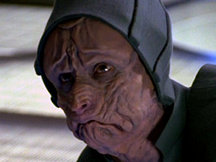 All of this points to a region that, at one time, was largely a technological utopia. The Briori, Pralor, Cravic, Sikarians, the 'Sky Spirits', and (comparatively-primitive) Vidiians and Trabe once shared this region of space as neighbors—technological giants with industrious culture, art, and literature. (Who knows—perhaps even the reclusive Botha were a bit friendlier when the neighborhood was nicer!) All of this points to a region that, at one time, was largely a technological utopia. The Briori, Pralor, Cravic, Sikarians, the 'Sky Spirits', and (comparatively-primitive) Vidiians and Trabe once shared this region of space as neighbors—technological giants with industrious culture, art, and literature. (Who knows—perhaps even the reclusive Botha were a bit friendlier when the neighborhood was nicer!)
 Certainly, there simmered a dark underbelly—with slavery festering in the heart of several civilizations, and secret resentments stirring between neighboring species... but for the most part, these advanced and peaceful reaches of the Delta Quadrant, sheltered from the Borg's prying eyes by the natural phenomenon of the Nekrit Expanse, and buffered from expanding as far as that barrier by the insulating hostility of the Swarm, would have appeared just as advanced, utopic, and friendly as the Federation and its surrounding powers in the Alpha Quadrant. Whether they held any sort of alliance (shades of 'The Four Races,' for Stargate SG-1 fans), or merely coexisted as disinterested but non-aggressive neighbors, their standard of living and technological level seemed to equal or even surpass the Federation's, and several of the cultures were given to the solely artistic and cultural pursuits that we see of the Federation in its pre-Borg golden age from early TNG. Certainly, there simmered a dark underbelly—with slavery festering in the heart of several civilizations, and secret resentments stirring between neighboring species... but for the most part, these advanced and peaceful reaches of the Delta Quadrant, sheltered from the Borg's prying eyes by the natural phenomenon of the Nekrit Expanse, and buffered from expanding as far as that barrier by the insulating hostility of the Swarm, would have appeared just as advanced, utopic, and friendly as the Federation and its surrounding powers in the Alpha Quadrant. Whether they held any sort of alliance (shades of 'The Four Races,' for Stargate SG-1 fans), or merely coexisted as disinterested but non-aggressive neighbors, their standard of living and technological level seemed to equal or even surpass the Federation's, and several of the cultures were given to the solely artistic and cultural pursuits that we see of the Federation in its pre-Borg golden age from early TNG.
 And then... one by one, they fell. The Phage consumed the Vidiians—turning them into a scourge that the more technologically-savvy races were clearly able to fend off, but the less-advanced civilizations of the region couldn't escape. The Briori fled in the face of a slave revolt, or were even destroyed by it. After engaging in a war, the Cravic and Pralor were slaughtered by their own machines once they endeavored to declare peace. We may conjecture that the ongoing Vidiian organ-harvesting, with fewer and fewer major powers to keep them in check, is what turned the Sikarians inward, and the Botha and Sky Spirits hostile and isolationist. Finally, the Trabe, once the primitives of the neighborhood, stood alone as a rival to the prowess of the Vidiians, at least enough to safeguard their own civilization... but having failed to learn the lessons of the Briori, they kept their own slave class... and eventually paid the price. And then... one by one, they fell. The Phage consumed the Vidiians—turning them into a scourge that the more technologically-savvy races were clearly able to fend off, but the less-advanced civilizations of the region couldn't escape. The Briori fled in the face of a slave revolt, or were even destroyed by it. After engaging in a war, the Cravic and Pralor were slaughtered by their own machines once they endeavored to declare peace. We may conjecture that the ongoing Vidiian organ-harvesting, with fewer and fewer major powers to keep them in check, is what turned the Sikarians inward, and the Botha and Sky Spirits hostile and isolationist. Finally, the Trabe, once the primitives of the neighborhood, stood alone as a rival to the prowess of the Vidiians, at least enough to safeguard their own civilization... but having failed to learn the lessons of the Briori, they kept their own slave class... and eventually paid the price.
Ironically, the first race to fall, almost 2000 years before, remained the longest; as scavengers and murderous thieves, the Vidiians survived. Little surprise, as that's all that their civilization was based on any longer. In its degenerate state, it endured, even as each of its more advanced neighbors vanished or withdrew.
By the time Voyager arrived on the scene, it was flying through the ruins of a realm that once looked disconcertingly like home; but now, only bare remnants of that once-mighty block of civilizations remained; little pockets of forgotten advancement, shielded by defenses of technology, illusion, or hostile atmosphere—while the Kazon and the Vidiians picked over the scraps of what was left.
Part IV: Outside Influences
In the long run, the fallen state of this section of the quadrant, which made Voyager such a prime target due to its unusually high technology, may have ended up saving the lives of the Kazon, Vidiians, Talaxians, and the other races sheltered by the Nekrit Expanse.
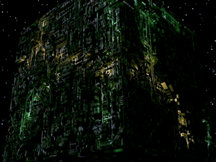 Some time between "The Best of Both Worlds, Part II" (2366) and the Borg's quasi-demise in 2378, the Borg encountered the Sikarians. While the circumstances are unknown and the potential for sites for the encounter are vast (after all, with the spatial trajector, the Sikarians could travel to any world within tens of thousands of lightyears), it is not too much of a stretch to suggest that this occurred sometime from 2367 to 2373 (the year that Seven of Nine was disconnected from the collective)... at which point the Borg opened a transwarp hub into this remote sector, past the outskirts of their territory, that they had never bothered with before. (Especially after losing a cube on the outskirts of the expanse in 2368, the ill-fated voyage of the cube that Riley Frazier and her compatriots were aboard; perhaps a first attempt to explore this region 'the old-fashioned way' by flying through the Nekrit Expanse). Some time between "The Best of Both Worlds, Part II" (2366) and the Borg's quasi-demise in 2378, the Borg encountered the Sikarians. While the circumstances are unknown and the potential for sites for the encounter are vast (after all, with the spatial trajector, the Sikarians could travel to any world within tens of thousands of lightyears), it is not too much of a stretch to suggest that this occurred sometime from 2367 to 2373 (the year that Seven of Nine was disconnected from the collective)... at which point the Borg opened a transwarp hub into this remote sector, past the outskirts of their territory, that they had never bothered with before. (Especially after losing a cube on the outskirts of the expanse in 2368, the ill-fated voyage of the cube that Riley Frazier and her compatriots were aboard; perhaps a first attempt to explore this region 'the old-fashioned way' by flying through the Nekrit Expanse).
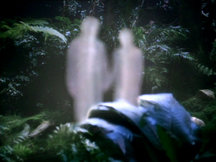 Here, the Borg presumably scoped the surrounding area, finding the Kazon a disappointment that 'detracted from perfection,' and little else of interest. Finding nothing of note beyond the Sikarians (whose biological and technological distinctiveness had already been absorbed by the group of individuals they'd encountered), the Borg elected to cut their losses and abandon this region of space. While this is conjecture, it would seem plausible based on the scraps of continuity that we do receive. Here, the Borg presumably scoped the surrounding area, finding the Kazon a disappointment that 'detracted from perfection,' and little else of interest. Finding nothing of note beyond the Sikarians (whose biological and technological distinctiveness had already been absorbed by the group of individuals they'd encountered), the Borg elected to cut their losses and abandon this region of space. While this is conjecture, it would seem plausible based on the scraps of continuity that we do receive.
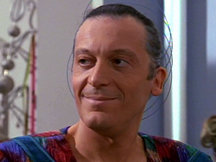 However, whether this is the precise sequence of events, or the Borg's probing to encounter the Kazon came far earlier and their interest in the Sikarians sparked a renewed interest in the region, it would seem that the high-technology powers of the region were fated to their demise; if not at their given times, then once the Sikarians' overreaching provoked the Borg's interest, the Briori, Pralor, Cravic, and healthy Vidiians would have doubtless stood out like a beacon to the Borg, leading to the entire 'neighborhood' quickly becoming a Borg enclave. At least, in its fallen state, the region proved of little interest—perhaps unwittingly sparing the entire troubled region after the Borg's curiosity was piqued. However, whether this is the precise sequence of events, or the Borg's probing to encounter the Kazon came far earlier and their interest in the Sikarians sparked a renewed interest in the region, it would seem that the high-technology powers of the region were fated to their demise; if not at their given times, then once the Sikarians' overreaching provoked the Borg's interest, the Briori, Pralor, Cravic, and healthy Vidiians would have doubtless stood out like a beacon to the Borg, leading to the entire 'neighborhood' quickly becoming a Borg enclave. At least, in its fallen state, the region proved of little interest—perhaps unwittingly sparing the entire troubled region after the Borg's curiosity was piqued.
 So, what comes of this Fallen Federation region in the future? By mid-2376, the Ocampa would be forced to come to the surface in the aftermath of the Caretaker's demise. However, they might not find such a troubled realm awaiting them. According to "Think Tank", some time before mid-2376 (within four years after Voyager's last encounter with the Vidiians), the Phage was cured by Kurros and his compatriots. (Which perhaps means that Dr. Danara Pel had a happy ending after all!) Kurros' description even suggested a potential return to their old, more enlightened ways of life. So, what comes of this Fallen Federation region in the future? By mid-2376, the Ocampa would be forced to come to the surface in the aftermath of the Caretaker's demise. However, they might not find such a troubled realm awaiting them. According to "Think Tank", some time before mid-2376 (within four years after Voyager's last encounter with the Vidiians), the Phage was cured by Kurros and his compatriots. (Which perhaps means that Dr. Danara Pel had a happy ending after all!) Kurros' description even suggested a potential return to their old, more enlightened ways of life.
While the scars on Vidiian society might take generations to heal, it is not too much of a stretch to imagine the Vidiians, no longer focused solely on life-prolongation but still very self-interested in safeguarding their own survival, turning their technology and superior vessels to 'cleaning up the neighborhood'—driving out the rowdy, rampaging Kazon and their self-destructive ways. Perhaps it was just such an eviction that drove the Kazon deeper into the Delta Quadrant to discover the Borg's abandoned transwarp network, by which they became an intergalactic irritant in the time of Prodigy. And indeed, when it comes to 'a new sheriff arriving in town,' as of early 2377, Kes, with all of her vast and heightened powers (and clearly able to cover vast distances in a short time), was headed back to her homeworld. And certain to serve as guardian for the Ocampa and their region of the Delta Quadrant.
Perhaps it is merely wishful thinking. But with the Vidiians theoretically able to return to a peaceful people—albeit one with a very dark shadow over their culture that might have lingering after-effects for centuries—and the Kazon having discovered far broader realms to plunder and explore, races like the Ocampa, the Baneans, Talaxians, and even the chastened remnants of the Trabe, might find themselves, post-Voyager, in a far less rugged and hostile quadrant. One to which peace has returned, for the first time in 2000 years. Perhaps even one that will, one day, again host a cadre of new technologically-advanced, benevolent civilizations... a sort of New Federation, if you will.
(Essay by Andrew Gilbertson)
|

